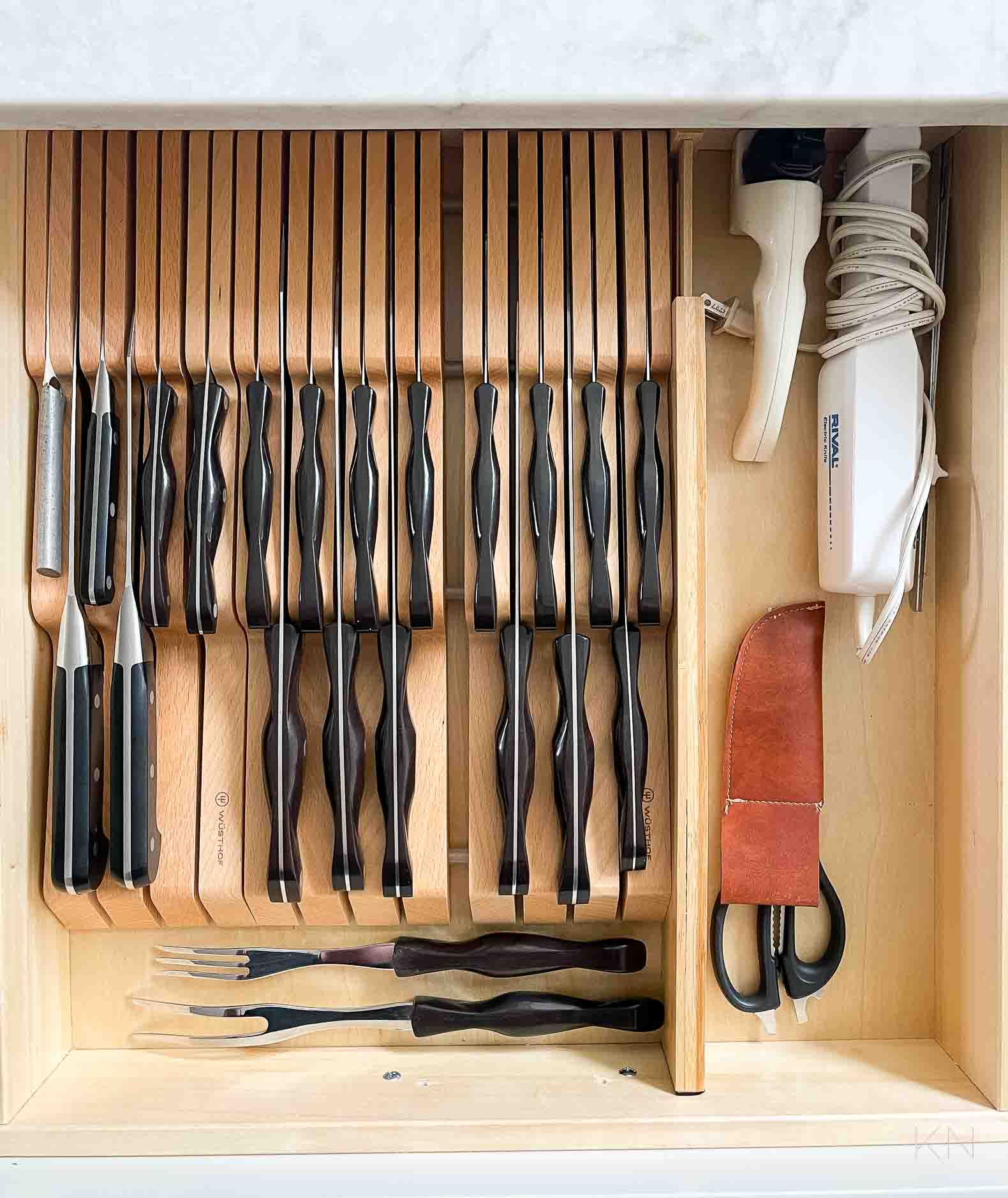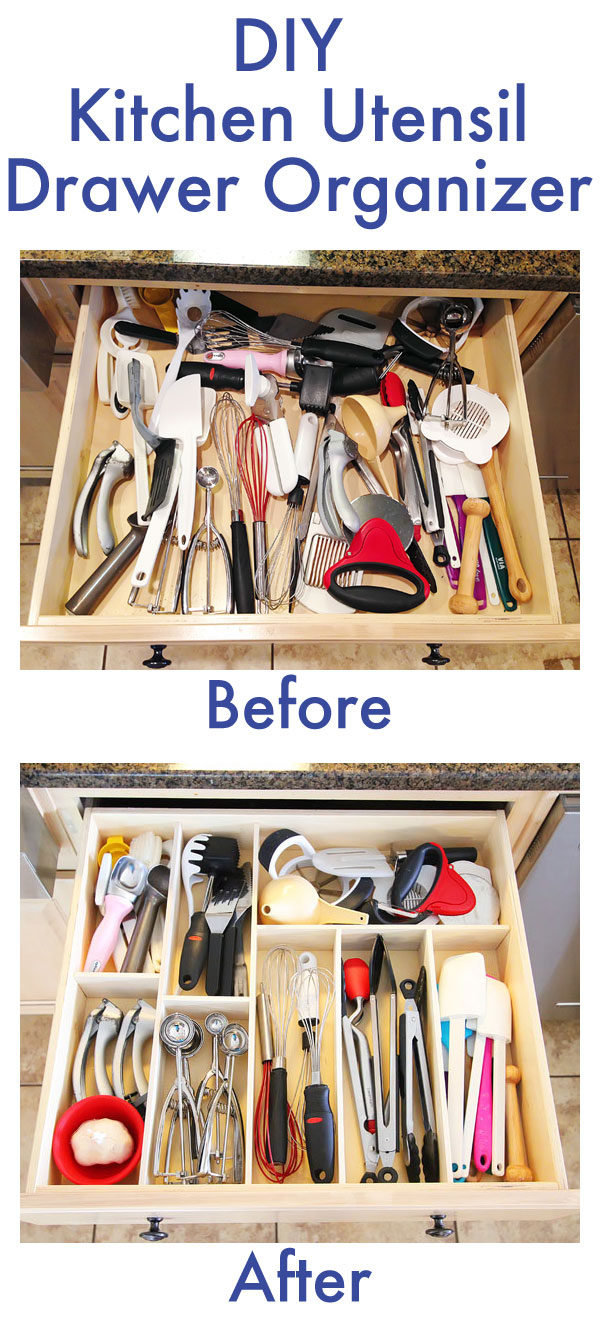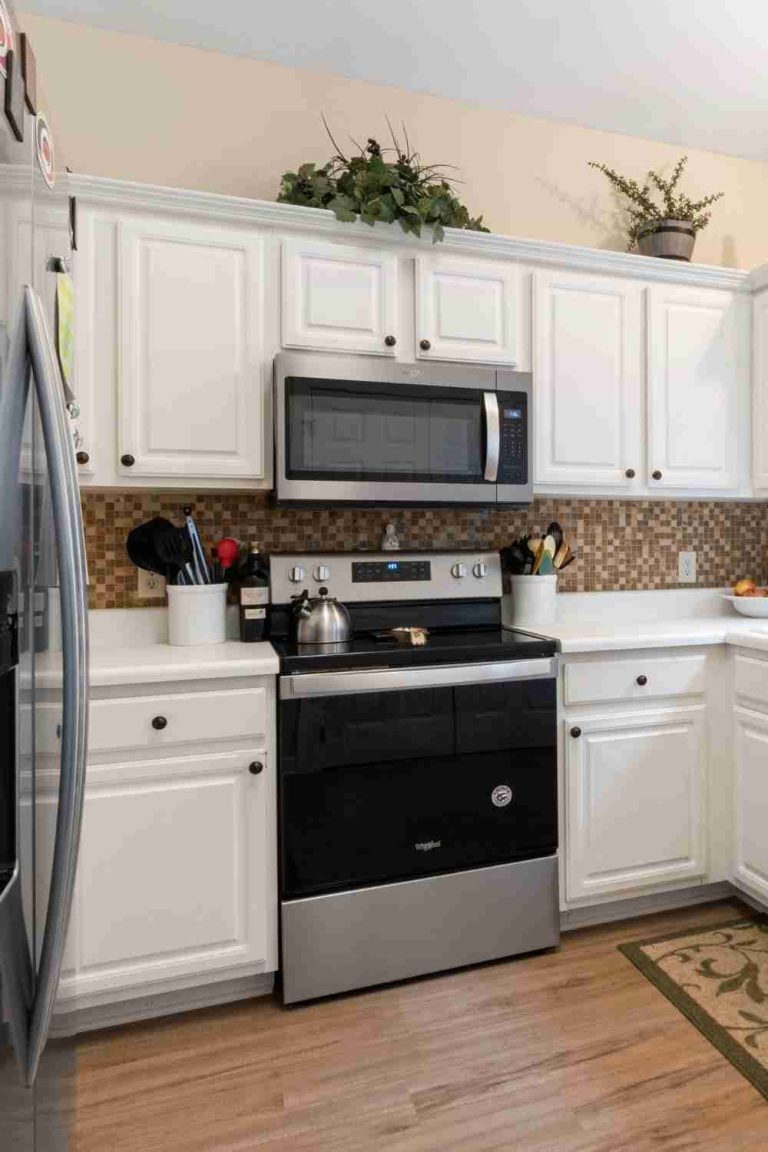How to Organize Large Utensils in Drawer: Smart Storage Solutions
How to Organize large utensils in a drawer by using adjustable dividers and upright container holders. These solutions maximize space and keep items easily accessible.
Tackling the chaos in the kitchen starts with organization, particularly when it comes to bulky items like large utensils. Nothing derails meal prep faster than a cluttered drawer filled with tangled whisks, spatulas, and serving spoons. A streamlined drawer not only saves time but also extends the life of your utensils by preventing scratches and damage.
Utilizing adjustable dividers allows customization to fit various sizes, ensuring everything has a place. Upright container holders are another effective method, making use of vertical space to neatly store your larger tools. By implementing these strategies, you’ll not only make cooking more enjoyable but also keep your utensils in tip-top shape for your next culinary adventure.
The Challenge Of Storing Large Utensils
The kitchen drawer can be like a wild jungle. Big spoons, spatulas, and whisks hide in the chaos. These jumbo gadgets need special homes to stay neat and ready for cooking magic.
Why Size Matters
Not all utensils are equal in the kitchen. The bigger they are, the harder they fit. Big tools can’t just slip into any slot. They need space, smart placement, and sometimes a bit of DIY magic to keep your drawers from jamming.
Typical Storage Struggles
- Lids and ladles sprawl, taking more space than small forks and knives.
- Oversized spatulas tangle, turning drawers into puzzles.
- Long handles jut out, blocking drawers from shutting tight.
Finding a spot for these kitchen giants means rethinking drawer space. Think dividers, hanging racks, or even custom slots. With the right strategy, every tool will have a place to call home.

Credit: kelleynan.com
Starting With A Clean Slate
Starting with a Clean Slate ensures that your utensils not only get organized but also get the fresh start they deserve. Imagine a clutter-free drawer where each ladle, spatula, and whisk stands proudly in its dedicated space. The journey to this kitchen utopia begins with two critical steps: emptying your drawers and deep cleaning before reorganization. Follow these steps to create a hygienic and well-arranged utensil drawer.
Emptying Your Drawers
Before organizing, you must empty your drawers. Take everything out. Lay it on the counter. This exposes the real space you have. It also lets you sort items easily. See what you use. Decide what stays or goes. Organizing starts with knowing your inventory. Keep this in mind:
- Sort utensils by type and frequency of use.
- Consider donating seldom-used items.
- Create piles for keeping, donating, or disposing.
Deep Cleaning Before Organizing
With drawers empty, now is the best time for a deep clean. Get rid of crumbs and residue. Wipe the interior with a damp cloth and mild cleaner. Let it dry completely. Remember:
- Remove dirt and leftover crumbs.
- Choose non-toxic cleaners for safety.
- Ensure the drawer is dry to prevent mold.
Organizing begins with removing old crumbs and sticky messes. A clean start keeps utensils hygienic. This also helps the organizers adhere better. Thus, utensils stay in place without slipping around. Embrace this fresh start. Bask in the joy of a clean, well-organized drawer.
Measuring Up For Success
Organizing large utensils can transform a cluttered kitchen drawer into a model of efficiency. The key to success is meticulous measuring, ensuring that every ladle, whisk, and spatula has its place. Prepare for a drawer revolution, where finding the right tool is a breeze, and every inch of space is optimized.
Assessing Drawer Dimensions
Before diving into the organization, know the exact size of your drawer. A tape measure is your best friend here. Measure the width, depth, and height of the drawer. Jot these numbers down; they’re crucial for selecting the right organizers. Pay special attention to any internal dividers or quirks that could affect space usage.
Understanding Utensil Sizes
Large utensils come in various shapes and sizes. Group them by type and measure their lengths and widths. This information helps determine the layout. Use this data to envision the perfect arrangement:
- Spoons and ladles: Long handles need deeper slots.
- Turners and tongs: Wider compartments accommodate their bulk.
- Measuring cups and whisks: Nesting or stacking could save space.
Think about how often you use each utensil. Your favorites should be easiest to reach. Now, let’s turn these measurements into a tidy drawer setup!
Segmentation: The Key To Order
Segmentation: The Key to Order transforms chaos into harmony within your kitchen drawers. Precise organization tools make finding the right utensil a breeze. A tidy drawer not only saves time but also extends the lifespan of your utensils by preventing scratches and damage. Let’s dive into how to neatly arrange those bulky items with strategic drawer segmentation.
Using Dividers Effectively
Drawer dividers are game-changers for managing large utensils. These adjustable barriers create designated spots for each tool:
- Measure drawer dimensions: Before buying dividers, know the size of your drawer.
- Select adjustable dividers: Choose dividers that you can move as your needs change.
- Install dividers vertically: Place them to form long slots perfect for spatulas and ladles.
Dividers not only keep things in place but also prevent jumbling when the drawer opens and closes.
Creating Categories For Your Utensils
Clustering similar items simplifies your search and ensures each utensil has its place:
- Categorize by type: Group utensils like whisks, tongs, and wooden spoons together.
- Categorize by use: Keep baking tools in one section and cooking tools in another.
- Label sections: Consider labeling each section for instant identification.
With clear categories, every spatula or whisk will find its home with ease, making your cooking experience more enjoyable.
Vertical Versus Horizontal Storage
Organizing your kitchen can be fun, especially when tackling large utensils. Choose between vertical or horizontal storage, and watch your kitchen drawers transform. Let’s dig into the benefits and uses of each layout.
Benefits Of Vertical Storage
Going vertical in your drawers is a game-changer. It’s not just about saving space—vertical storage has a lot to offer:
- Easier access: No need to rummage through clutter. Vertical storage provides a clear view of your tools.
- Maximize space: Make room for more by aligning utensils on their sides, fitting more into tight places.
- Protects utensils: Less scraping and bumping mean your items stay in top shape.
- Organized look: Open a drawer to see a neat lineup, making selection quick and simple.
When To Use Horizontal Storage
Sometimes, horizontal is the way to go. Here’s when to lay those kitchen tools flat:
- Large, flat items: Think chopping boards and baking sheets. They slide in perfectly.
- Drawer depth limits: Shallow drawers require flat laying to shut neatly.
- Wide utensils: Pizza cutters or large spatulas might fit better horizontally.
- Combined storage: Mix it up with some tools vertical, some horizontal, for custom fit.
Custom Drawer Inserts For The Win
Struggling to keep those large kitchen utensils organized? Say goodbye to cluttered drawers! Custom drawer inserts can transform your kitchen organization game.
Perfectly sized compartments mean a place for everything. From ladles to rolling pins, inserts keep utensils within reach.
Diy Solutions
The creative, hands-on approach to drawer organization.
- Measure your drawer dimensions
- Pick materials like wood or acrylic sheets
- Cut and arrange to fit your utensils
Your unique needs lead the design process.
Pre-made Drawer Organizers
No time to DIY? Pre-made options save the day.
- Browse online or in-store selections
- Consider adjustable models for flexibility
- Choose organizers that maximize space
It’s effortless organization at your fingertips.
Multiplying Space With Tiered Organizers
The secret to a clutter-free kitchen starts with maximizing drawer space. The magic trick is simple: tiered organizers turn a chaotic utensil drawer into an orderly storage haven.
Leveraging Vertical Space
Don’t let the height of your drawer go to waste. Stackable tiers can double, or even triple, your storage capabilities.
- Adjustable inserts: Fit various utensil sizes
- Sliding components: Allow easy access to lower tiers
- Custom builds: Maximize every inch of drawer height
Choosing The Right Tiered Solutions
Selecting an ideal tiered organizer involves assessment. Consider drawer dimensions and utensil types.
| Criteria | Details |
|---|---|
| Material | Wood, plastic, metal options |
| Size | Match organizer to drawer dimensions |
| Compartments | Varying sizes for different utensils |
Remember to measure your drawer before buying. A tiered organizer should fit snugly.
:strip_icc()/kitchen-drawer-organize-silverware0JayjfI0q9FAHTOsWM8YyW-51832f216a3c4f289149e6cd18972532.jpg)
Credit: www.bhg.com
Adopting A Minimalist Approach
Embrace simplicity in the kitchen by adopting a minimalist approach. Streamline your space and make cooking easier. A clutter-free drawer filled with only must-have tools awaits.
Decluttering Your Utensils
Start with a clean slate. Empty your utensil drawer completely. Take each item in hand and ask if it serves a purpose. Be honest. If it hasn’t been used in months, it’s time to say goodbye. Group your tools into categories and keep only the essentials. Your pizza cutter might be fun, but a sharp knife does the trick too. With fewer items, your drawer stays tidy and items are easy to find.
The One-in, One-out Rule
Prevent clutter with the one-in, one-out rule. Purchase a new utensil? Remove an old one. This keeps your collection manageable and your drawer spacious. Hang on to versatile tools, like a strong spoon that stirs and serves. Say farewell to items that have a single, rare use.
Remember, a minimalist kitchen drawer isn’t barren, it’s practical. It makes room for ease and efficiency.
Maintaining Your Organizational Zen
Imagine opening your kitchen drawer to a sight of pure calm. No more large utensils tangled together. This dream can be a daily reality with a touch of organizational zen. Let’s explore simple habits and strategies that will keep your kitchen drawers in a state of perfect harmony.
Daily Practices
Maintaining an orderly drawer starts with daily habits. Focus on these small steps:
- Return items to their designated spot after washing.
- Use drawer dividers to create a place for each utensil.
- Keep only what you need. Donate or discard duplicates.
Regular Reviews And Audits
Inspect utensil drawer organization monthly. Aim to keep it clutter-free. Here is a checklist:
- Remove items that don’t belong in the drawer.
- Check for wear and tear. Replace items as needed.
- Reassess organizers for functionality. Adjust if necessary.

Credit: www.kevinandamanda.com
Smart Tips And Tricks
Cramped kitchen drawers can be a real headache, especially when filled with oversized utensils. But fear not! These smart tips and tricks will help transform that jumbled chaos into an organized haven.
Storing Occasional Use Items Elsewhere
Start by separating utensils based on frequency of use. Aim to keep your drawer clutter-free.
- Identify utensils used less than once a month.
- Find new homes for these items, like a high shelf or a storage bin.
- Enjoy access to everyday tools without digging through the rarely used ones.
Labeling For Convenience
Labels are lifesavers when it comes to quick identification. Take a few simple steps:
- Create categories for utensils like “Baking”, “Grilling”, or “Stirring”.
- Use a label maker or write on washi tape for each drawer section.
- Place utensils in the aptly labeled spots.
- Retrieve items swiftly without the need to search.
Frequently Asked Questions Of How To Organize Large Utensils In Drawer
What Are Drawer Organizer Essentials For Utensils?
Drawer dividers are the most essential organizers for arranging large utensils, providing separate compartments for easier access and categorization.
How To Maximize Space For Large Kitchen Tools?
Use vertical storage solutions like upright holders or pegboards inside drawers to accommodate large kitchen tools without wasting space.
Can Diy Dividers Help In Utensil Organization?
DIY dividers can be cost-effective and customizable, ensuring a perfect fit for your large utensils and specific drawer dimensions.
Best Materials For Durable Utensil Drawer Organizers?
High-quality plastic, metal, or bamboo are durable materials for utensil drawer organizers, offering longevity and ease of cleaning.
Tips For Maintaining An Organized Utensil Drawer?
Regular decluttering, categorizing utensils by frequency of use, and promptly returning items to their designated spots help maintain an organized utensil drawer.
Conclusion
Organizing large utensils in a drawer need not be daunting. With the right dividers and storage solutions, you can easily find your tools when you need them. Remember, a tidy drawer saves time and reduces kitchen stress. Take the plunge and transform your cluttered utensil drawer into a model of efficiency!






